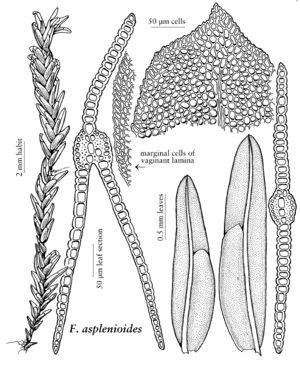Difference between revisions of "Fissidens asplenioides"
Sp. Musc. Frond., 156. 1801,.
imported>Volume Importer |
imported>Volume Importer |
||
| Line 41: | Line 41: | ||
|publication year= | |publication year= | ||
|special status= | |special status= | ||
| − | |source xml=https:// | + | |source xml=https://bitbucket.org/aafc-mbb/fna-data-curation/src/2e0870ddd59836b60bcf96646a41e87ea5a5943a/coarse_grained_fna_xml/V27/V27_462.xml |
|genus=Fissidens | |genus=Fissidens | ||
|species=Fissidens asplenioides | |species=Fissidens asplenioides | ||
Latest revision as of 21:26, 5 November 2020
Plants to 250 × 4 mm. Stem unbranched and sparingly branched; axillary hyaline nodules weak; central strand present. Leaves in as many as 25 pairs, often undulate, mostly lingulate, rounded to obtuse to broadly acute, sometimes apiculate, to 4 × 0.5 mm; dorsal lamina narrowed proximally, ending before or at insertion, not decurrent; vaginant laminae 1/2–3/4 the leaf length, unequal, minor lamina of most leaves rounded and free distally, or narrowed distally and ending on or near costa; margin ± entire to crenulate-serrulate, sometimes unevenly so distally, elimbate except for a weak limbidium in the proximal parts of vaginant laminae, limbidial cells 1-stratose; costa ending several cells before apex, oblongifolius-type, distal part of leaf in transverse section showing enlarged cells arranged in a single row; laminal cells of dorsal and ventral laminae 1-stratose, distinct, smooth, lenticularly thickened but appearing bulging, firm-walled, irregularly hexagonal, 7–12 µm long; juxtacostal and interior proximal cells of vaginant laminae 1-stratose, smooth, plane, quadrate to ± oblong, larger; medial marginal cells of vaginant laminae ± elongate, oriented obliquely. Sexual condition dioicous; perigonia and perichaetia on elongate stems; naked archegonia at times in axils of distal leaves. Sporophytes 1–2 per perichaetium, orange-red. Seta to 6 mm. Capsule theca ± erect, radially symmetric to slightly arcuate, bilaterally symmetric, to 1.5 mm; peristome taxifolius-type; operculum ± as long as theca. Calyptra cucullate, smooth, 1–1.7 µm. Spores 7.5–12 µm.
Habitat: Sandstone ledges and crevices in moist ravines and grottoes, usually along streams and waterfalls
Distribution

Ala., Ga., Ky., La., Miss., N.C., S.C., Mexico, West Indies, Central America, South America, Asia, Africa, Atlantic Islands (Macaronesia), Pacific Islands (New Zealand), Australia.
Discussion
Fissidens asplenioides, usually a robust species, is recognized by leaves typically curled tightly inward from the tips when dry, a minor lamina that in most leaves is rounded distally and attached more or less only along costa, lenticularly thickened dorsal and ventral laminal cells, elongate medial marginal cells of the vaginant laminae oriented obliquely, and oblongifolius-type costa which in the distal part of the leaf in transverse section shows a single row of enlarged cells. The oblongifolius-type costa, found in F. asplenioides and F. santa-clarensis, is unique to sect. Amblyothallia of subg. Pachyfissidens (R. A. Pursell and M. A. Bruggeman-Nannenga 2004). Subterranean, multicellular, irregularly globose, rhizoidal gemmae have been reported in Macaronesian specimens of F. asplenioides.
Selected References
None.
